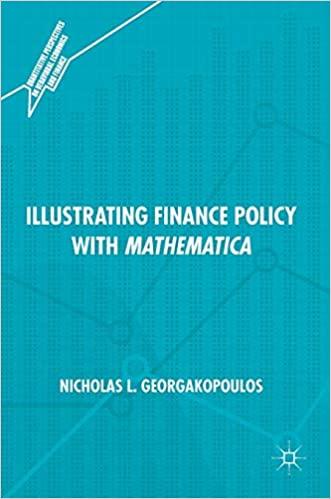Question
CAPM The firm's cost of retained earnings can be estimated using the CAPM equation as follows: rs = rRF + (RPM)bi = rRF + (rM
CAPM The firm's cost of retained earnings can be estimated using the CAPM equation as follows: rs = rRF + (RPM)bi = rRF + (rM - rRF)bi The CAPM estimate of rs is equal to the risk-free rate, rRF, plus a risk premium that is equal to the risk premium on an average stock, (rM - rRF), scaled up or down to reflect the particular stock's risk as measured by its beta coefficient, bi. This model assumes that a firm's stockholders are -Select-wellsomewhatnot well diversified, but if they are -Select-wellsomewhatnot well diversified, then the firm's true investment risk would not be measured by -Select-growthbetayield and the CAPM estimate would -Select-understateoverstateapproximate the correct value of rs. Bond Yield Plus Risk Premium If reliable inputs for the CAPM are not available as would be true for a closely held company, analysts often use a subjective procedure to estimate the cost of equity. Empirical studies suggest that the risk premium on a firm's stock over its own bonds generally ranges from 3 to 5 percentage points. The equation is shown as: rs = Bond yield + Risk premium. Note that this risk premium is -Select-identical todifferent from the risk premium given in the CAPM. This method doesn't produce a precise cost of equity, but does provide a ballpark estimate. DCF Quantitative Problem: Barton Industries estimates its cost of common equity by using three approaches: the CAPM, the bond-yield-plus-risk-premium approach, and the DCF model. Barton expects next year's annual dividend, D1, to be $1.90 and it expects dividends to grow at a constant rate g = 5.2%. The firm's current common stock price, P0, is $20.00. The current risk-free rate, rRF, = 5%; the market risk premium, RPM, = 6.3%, and the firm's stock has a current beta, b, = 1.1. Assume that the firm's cost of debt, rd, is 9.02%. The firm uses a 4.3% risk premium when arriving at a ballpark estimate of its cost of equity using the bond-yield-plus-risk-premium approach. What is the firm's cost of equity using each of these three approaches? Round your answers to 2 decimal places.
CAPM cost of equity: ________%
Bond yield plus risk premium: ________%
DCF cost of equity: _________%
What is your best estimate of the firm's cost of equity?
Step by Step Solution
There are 3 Steps involved in it
Step: 1

Get Instant Access to Expert-Tailored Solutions
See step-by-step solutions with expert insights and AI powered tools for academic success
Step: 2

Step: 3

Ace Your Homework with AI
Get the answers you need in no time with our AI-driven, step-by-step assistance
Get Started


